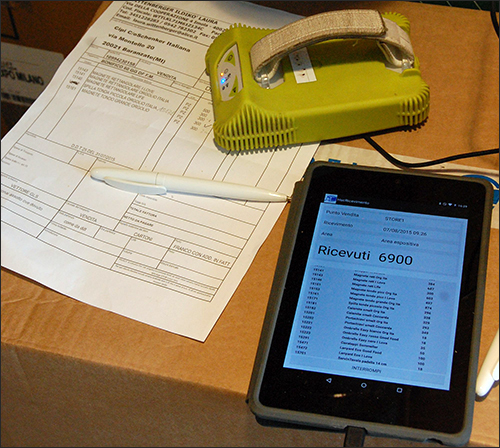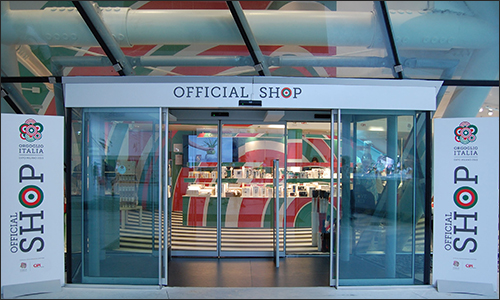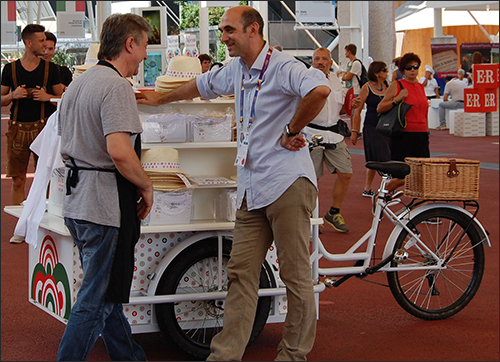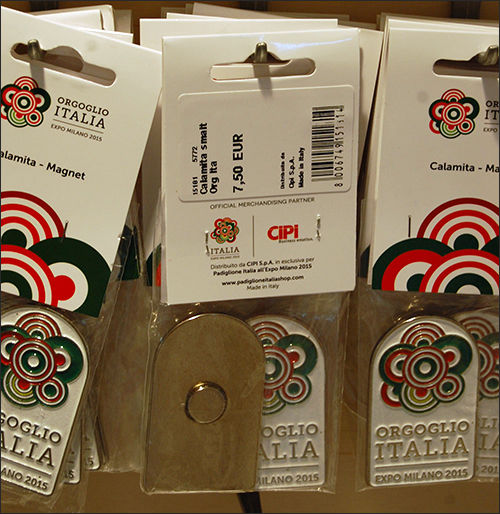At Expo Milano, RFID Tracks Thousands of Products
time: 2015-10-21 16:17
Every piece of merchandise received by the Shop of the Italian Pavilion is identified via an EPC UHF tag, to ensure that none of the Italian-themed merchandise is out of stock, as well as expedite sale transactions and control theft.
By Claire Swedberg
At Expo 2015, the six-month-long World's Fair currently taking place near Milan, Italy, the Shop of the Italian Pavilion sells tens of thousands of merchandise items, ranging from pins and towels to clothing and umbrellas. Each of the Italian Pavilion's 12,000 daily visitors must walk through the store, and many of them buy something during their visit. The store's operator, CIPI Spa, is using RFID technology to manage this merchandise and ensure that it is available on the shelf for buyers, as well as to quickly process transactions at the point of sale (POS) and track goods on their way out the door, in order to prevent theft. The passive ultrahigh-frequency (UHF) RFID system is provided by Italian wireless technology integrator H&S Custom.
The theme of Expo Milano, which runs until Oct. 31, is "Feeding the Planet, Energy for Life." Located approximately 15 kilometers (9.3 miles) northwest of Milan, the fair includes 145 participating countries, 60 pavilions, nine thematic clusters, 150 restaurants, and various kiosks, street food stations and shops.

When the goods arrive at the Shop of the Italian Pavilion, a worker uses a CAEN qID handheld reader (model R1240I) to read each item's tag.
The Shop of the Italian Pavilion is laid out in such a way that every visitor must pass through the store, as a way of encouraging him or her to browse the various Italian-themed goods available for sale. There are typically 25,000 to 35,000 merchandise items on sale at any given time, and 2,500 or more items are typically sold each day.
An Expo can be a uniquely profitable and yet challenging place to sell merchandise, says Renzo Ottina, H&S Custom's CEO. The sheer volume of people moving through and browsing within the store makes it difficult for staff members to keep track of what's on the shelves at any specific time. If a product is not on the shelf, a sales opportunity could be lost, since a buyer will not likely return to the store after leaving empty-handed. So while customers are typically in the mood to shop, if they don't see something they like on the shelves, the sale won't happen. "Most people are oriented toward buying something," Ottina says, "so it's quite important to have 100 percent availability."

Every piece of merchandise sold in the Shop of the Italian Pavilion is fitted with a UHF RFID label made with an NXP Ucode G2iL chip.
Because of the wide variety of merchandise, from pasta to wines and other souvenirs, as well as the high volume of sales, restocking shelves daily or weekly takes hours of effort to complete. To make this process more manageable, H&S Custom developed an RFID system in which every item—ranging from a €1 ($1.13)pen to a high-value product—is tracked via an EPC Gen 2 passive UHF RFID tag from the time it arrives at the store until it leaves in the hands of a customer.
Without RFID, Ottina says, the large number of suppliers directly shipping goods to CIPI's warehouse in Catania "would have surely made [CIPI] lose the control of the stock. Thinking to delegate to the store personnel the incoming control of thousands of pieces without the proper tools would have been unquestionably unrealistic."
H&S Custom began working with CIPI managers three months before the Expo opened on May 1. The solution consists of H&S Custom software on its hosted server, in addition to RFID readers at the store and RFID printers in two of CIPI's offices (one in Milan, the other in Catania), where product orders for the store are placed, based on data presented in the store's inventory software.

Shop of the Italian Pavilion employees that operate pedal-powered carts use an RFID Global near-field reader to document which items they sell.
First, CIPI office workers use a Toshiba Tec BEX4T RFID printer to print Smartres UHF RFID labels made with built-in NXP Semiconductors Ucode G2iL chips, each encoded with a unique ID number linked to the stock-keeping unit (SKU) of the product being ordered. The process of printing and encoding the RFID labels, with each label's encoded ID number linked to a particular SKU, creates a record in the software so that the specific item will then be expected at the store. The office worker then sends an order for goods, along with the printed labels, either to the appropriate merchandise supplier or to CIPI's warehouse.
The merchandise supplier or Catania warehouse receives the order and RFID labels, and workers pick the appropriate items, which are packed in boxes, loaded onto pallets and then shipped. Once the goods arrive at the Shop of the Italian Pavilion, an employee usesCAEN qID handheld reader (model R1240I), connected to an Android tablet, to interrogate the items' tags, typically without opening the box. The software accessed on the tablet displays which items are in the box, compares that list against what was supposed to have been shipped, and is then updated to indicate what the store has actually received.

H&S Custom's Renzo Ottina
Early in the morning at least twice a week, the goods are then delivered from the warehouse to the store. There, staff members spend several hours loading the products onto shelves and ensuring that none of the shelves are empty before the business opens its doors at 10 a.m.
Throughout the day, personnel can then carry a CAEN RFID reader and tablet around the store to obtain an updated inventory list. Since there are so many products, each worker typically performs an inventory check focused on a specific type of merchandise, such as pants or flags. He or she can then ascertain what is missing, has been placed in the wrong part of the store or requires replenishment.
Upon selecting an item to buy, a customer brings it to one of the shop's three sales counters, each fitted with an RFID Global by Softwork MRU80 reader with an integrated near-field antenna. The merchandise is placed over or near the reader and the POS software, part of H&S Custom's platform, lists the goods being purchased, provides sales details (such as the total cost) and updates inventory to indicate what has been sold. Each tag's memory is also updated to confirm that the item to which the tag is attached was sold.
As the shopper walks out of the store, he or she passes a Keonn Technologies AdvanSafe antitheft RFID reader and integrated antenna, which captures the tag IDs and forwards them to the software. The software then determines whether each item has been paid for (an alarm sounds if this is not the case), and the inventory can be updated to indicate that an item has been taken out of the store, even if it was not purchased. This data provides redundancy for the software; however, tags are sometimes removed from merchandise before a customer leaves the store, especially if that person is buying a hat that he or she wishes to wear right away. In such a situation, the reading of the tags at the point of sale provides the inventory system with sufficient data to proceed with replenishment orders.

During the past six months, the Shop of the Italian Pavilion has received 320,000 RFID-tagged pieces of merchandise.
The store also has sales workers that ride pedal-powered carts around the fairgrounds, selling goods to visitors throughout the Expo. Such employees utilize a Microsoft Windows tablet and an RFID Global near-field reader to interrogate the tags of any items, in order to accomplish the sales and automatically update the inventory list in the software via the tablet's cellular connection.
Altogether, CIPI has printed 320,000 RFID labels to date, of which thousands will likely remain on merchandise that has not yet been sold.The technology will help the company track goods even after the Expo ends. All products not sold at the Expo must be destroyed, and by monitoring that process via the RFID tags, CIPI can be assured that the items will not end up being sold by other, unauthorized channels at discount prices.
The RFID system has enabled the tracking of tens of thousands of products on a weekly basis as they pass through the warehouse and store, but there were various challenges related to tagging all of those items. According to Ottina, CIPI and H&S considered tagging only high-value goods, but found that tagging some merchandise and not others was simply too complicated. Instead, they chose to tag everything, including very low-cost items.Therefore, a box of pens or other small objects could be easily accounted for and tracked, saving labor for store and warehouse personnel, even if each item was worth a only single euro. Some goods made the reading of tags nearly impossible—for instance, food items packed in metallic packaging and liquids. However, he says, the tags were applied to them as well. For any tags that could not be read, employees at the point of sale simply keyed in the tag ID printed on the front of the RFID label to transact a purchase.
The short timeframe for tagging the goods was one of the greatest challenges, Ottina says. Just a week or two before the store opened,CIPI received approval to sell specific products, the SKUs of which then had to be entered into the software so that the RFID labels could be printed at CIPI's offices. "We worked very quickly," he states.